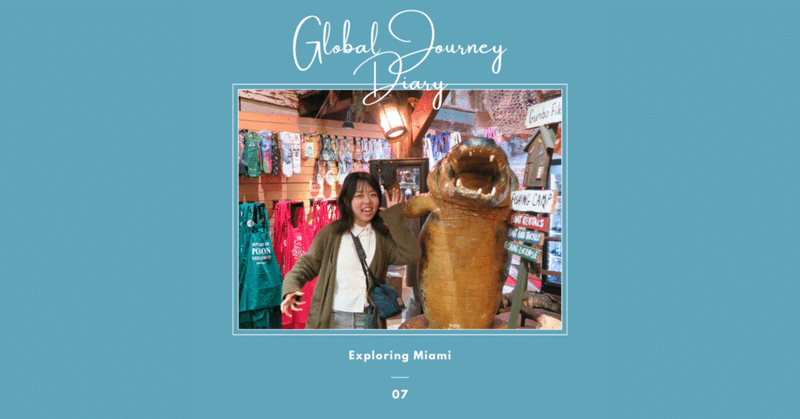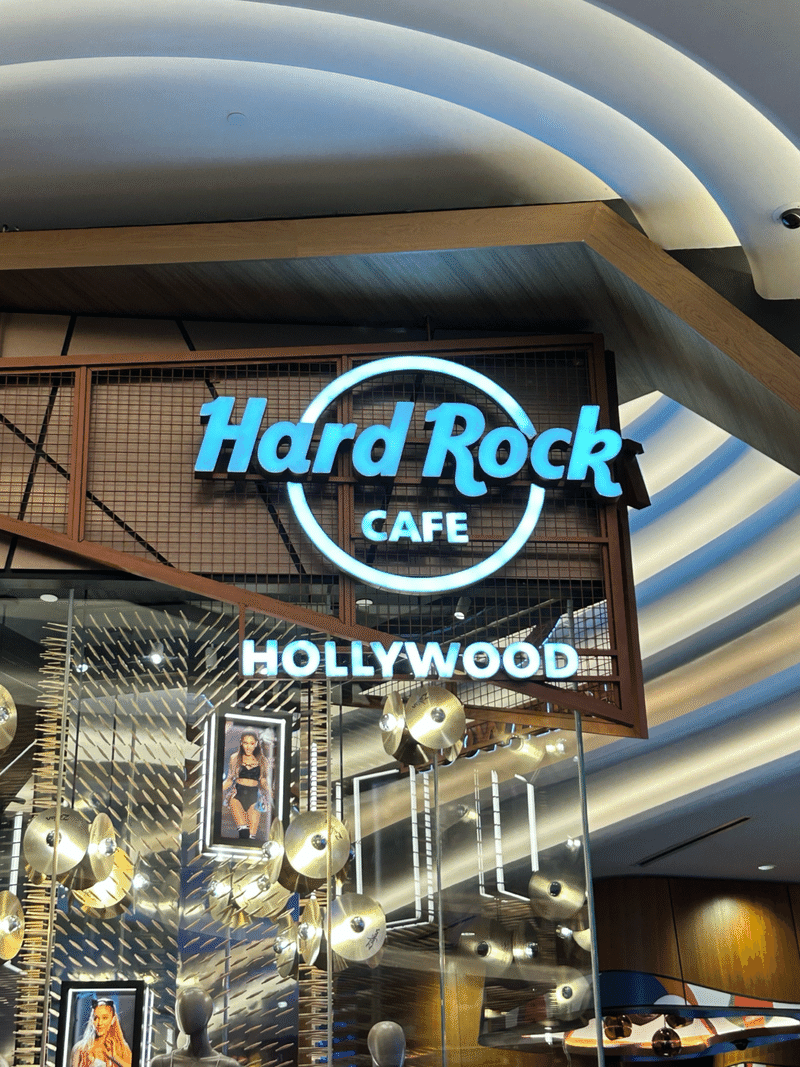
Global Journey Blog vol.7 -Yui Ikegami
Hi all! I’m Yui.
I have about a month and a half left in my life in Miami, and I am getting more and more enthusiastic about what I want to accomplish.
I am majoring in tourism in Miami, and I feel that it is a great advantage to be able to study tourism here.
Miami is a rapidly growing city as a tourist destination. In the past, Miami was a "summer resort for the wealthy," attracting many tourists from outside the U.S., such as Canada and the U.K.
However, the covid has made it a rapidly growing city that is attracting attention in the country as well, since it is easy to avoid infection due to the warmth and vastness of the land.
I had the opportunity to hear two guest speakers in my tourism class that inspired me to write this blog.
GMCVB (Greater Miami Convention &Visitors Bereau. A non-profit organization dedicated to promoting tourism to the Miami CBD and beaches)
Visit Lauderdale (a government organization that markets tourism in Fort Lauderdale, a coastal city northeast of Miami).
I would like to share the current situation in Miami based on the information and data I have received from these organizations.
While Miami is attracting attention as a tourist destination, and efforts are being made to develop the land and improve the environment, the effects of these efforts can be seen in various ways.
In this topic, I would like to talk about some of the issues that have arisen as a result of tourism and its impact on people's lives, based on my experience as an exchange student in Miami.

A rapidly growing tourist destination since the dawn of the covid
As I briefly mentioned earlier, Miami began to attract attention in the U.S. after the pandemic, and since 2021, it has been one of the fastest-growing cities in the country in terms of the number of visitors.
Miami's appeal as a tourist destination is full of elements, such as a comfortable climate even in winter, beautiful beaches that can be enjoyed year-round, and restaurants that offer cuisine from around the world.
Especially in terms of food culture, new restaurants are opening one after another, including those of Michelin-starred chefs, and you can enjoy flavors from all over the world. One of the most popular courses is the "omakase" course, where the chef serves the food right in front of you on a teppan (iron plate).
The weekends are always filled with large scale events, offering a wide variety of experiences, from live performances by famous artists to sports games.
In the past few months, there have been live performances by rappers Travis Scott and Drake, a soccer game with Messi's team, and the Ultra music festival, a music festival for over 100,000 people.
One of my personal favorite events is the South Beach Wine & Food Festival held every year at the end of February.
I participated as a volunteer at this food festival where famous chefs gather.
I enjoyed participating in the event as a chef's assistant and setting up the event, but the admission fee for a regular attendee ranged from $300 (about 45,000 yen) to over $1,000 depending on the venue.
The DJs and chefs who performed at the event were very well-known. (I am not familiar with them, but my friends and other volunteers were very excited.)

The city is also preparing for big events, such as the third-place game of the FIFA World Cup in 2026, and construction of hotels, mainly for major brands, and additions to the airport and cruise ship terminals are underway one after another.

The Seminole HardRock Hotel, a hotel with a casino, is famous for its fanciness, with rates starting at $400~500 per night (60,000~70,000 Japanese yen).

Impact on Life here
While the city is developing rapidly due to tourism, there are some effects on daily life.
First, the cost of living is too high. The cost of shopping at supermarkets, driving around by car, and even dinner can be very expensive, and this may not be limited to Miami. Many restaurants are upscale, so you will have to pay more for service and tip more.
For example, a sandwich here costs about $21, 3,000 yen.

This ajillo is about $24, 3,500 yen.

I am always conflicted between wanting to enjoy the food experience in a limited time and feeling that it is too expensive, but I am grateful for this experience and do my best to enjoy it when I decide to go.
Also, when the amount of food is too much, I try to take it home and divide it into several meals. By doing so, I feel a little lighter.
Traffic congestion is also serious.
In the central district, we are trying to ease traffic congestion with monorails and buses, but it can take a long time to get from downtown, the beach, and other classic spots to the campus (when moving quickly east-west).
When my return time falls during the peak hours, I either leave for a later time or prepare for the return trip with my friends.
Also, once a week, I take a bus to the campus by the sea, which is an hour away, and depending on the time of day, I may be delayed for 30 minutes to an hour.
In the summer, the road was blocked by construction for road expansion, and there were often heavy traffic jams." There were days when I was rocked for more than two hours to get home, thinking, "Traffic jams due to road closures for road expansion...

Another problem cited is the difficulty in maintaining security due to the increase in tourism.
Miami became a popular spring break destination in the 1960s, partly because it was the setting for a movie. A professor, who is almost 70 years old, enjoyed his spring break in Miami in the 1970s when he was a university student.
The weather in Miami these days is not at all like winter, with temperatures reaching over 30 degrees Celsius on some days. I feel that such a mild climate is one of the major attractions of the city.
However, due to the constant troubles and incidents related to alcohol and clubs, it seems that this year, more than ever before, large and strict regulations will be set up to prevent the deterioration of public safety.
As the middle two weeks of March (just now) is the busiest time of the year, the government is responding by restricting entry to beaches, limiting the use of parking lots and raising fees, and prohibiting drinking and smoking.
Through my classes, I sometimes learn about examples of famous cities that restrict tourism, but I think it is a good opportunity to see firsthand how such restrictions are enforced on a large scale.

What I feel about Miami's tourism policy is that it is very upscale.
The new malls and hotels are all luxurious and flashy in design, and the food served is sophisticated and expensive.

However, I believe that Miami's appeal as a tourist destination is not limited to its warm climate and luxurious resorts, but also to its diverse culture.
Away from some of the more urbanized areas, there are vast wetlands. Some areas have been inhabited by Native Americans and are truly rich in ecosystems.
I once visited the Everglades, a national nature park, which is a rare place where two types of alligators, wild crocodiles and alligators, live, and a vast area where more than 1,000 types of vegetation can be found.


Also, as we have mentioned several times, the city is strongly influenced by immigrants from South America; as of 2019, it had the highest number of immigrants, surpassing New York and Los Angeles. Since then, the number of people moving to the U.S. seems to continue to increase due to the economic downturn caused by the pandemic.
Here is the information I referenced, if you are interested
https://www.migrationpolicy.org/article/south-american-immigrants-united-states(Jane Lorenzi and Jeanne Batalova. South American Immigrants in the United States. 2.16.2022)
https://news.miami.edu/stories/2023/02/record-breaking-number-of-migrants-place-burden-on-city-resources.html
(Caroline Vail; Record-breaking number of migrants place burden on city resources, 2.22.2023)
In addition to cuisine, I often sense Latin elements in music and art, and I don't think it feels American in the best sense of the word. I feel that such a rich diversity and vibrant culture can attract and entertain even more people, depending on how it is presented.
In Conclusion
In this article, I have considered the impact of tourism, both from what I have learned in my classes as a tourism major and from my own perspective as a student living here.
I was able to experience modern, yet unabashedly fancy hospitality in a place that is at its peak as a tourist destination and on the verge of prosperity,
And I feel it was very valuable to see how the city is aiming for sustainable urban development, taking into consideration the environment and tourism pollution. It is one of the reasons why I feel so happy to have come here.
By the time of my next blog, it will be just before I return home. I hope to leave you with some reflections and feelings about my study abroad experience.
I will cherish every day so that I can say with all my heart that I have made it through the last spurt.
Thank you very much for reading.
この記事が気に入ったらサポートをしてみませんか?
